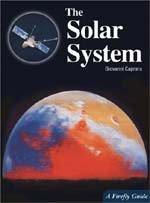
Our solar system is our neighbourhood. It is what supports our life, sets us apart from other regions of space and even protects us from extra-solar visitors. Yet our knowledge of this region is frustratingly incomplete. Not only is the physical space dauntingly large but the time scale of its existence is equally vast. Giovanni Caprara in his book “The Solar System” provides us with an up to date account of what we have observed in our solar system and demonstrates some of the physical processes taking place both now and at earlier times.
Caprara starts by presenting the most accepted methods for solar system formation and he continually returns to this when considering the formation of each of the planets. As interstellar dust and gas are the core building blocks there is a lot of room for variety. Perhaps what is more surprising is the quantity of similarities and patterns that result.
With an extensive chapter for the sun and each planet the reader can both learn specific details as well as make comparative studies. There are descriptions of these bodies’ physical characteristics such as the size, the distance from the Sun and the mass. Where appropriate Caprara discusses the atmosphere and climate. Also he presents distinctive surface features and their causes such as asteroid impacts or plate tectonics. He guesses at the body’s internal structure though except for the Earth and Moon there is no data to provide corroboration. If the planets have their own satellites he describes each individually in much the same manner. What these details readily show is that we really do live in a system with all components inherently linked to one another.
Pleasantly interposed within the text are vignettes that tell the reader how the information was obtained. Usually each vignette has an accompanying pictorial representation whether a drawing by 17’th century astronomers, plates from ground-based observatories or images from space probes. As most of the images are of recent photographs from space probes they add a current feel to the book. What becomes readily apparent is that only with advances to our observational ability will we get advances in our understanding.
There is also a purposeful tie-in with this information to our own benefit on Earth. The process of global warming is evident on Venus. Tidal effects between Io and Jupiter are equally present between the Earth and Moon. Asteroids are present in large numbers and obviously continually strike as seen when Shoemaker-Levy hit Jupiter. And, as seen with other stars, our Sun will eventually change and make life on Earth untenable. Knowing about our neighbourhood isn’t just for cursory interest it can also help with our survival
This book is a good source of information though a more robust list of references would aid those looking for greater detail. Also, there seems to be a few errors either from the original text or the translation. However none of these detract from the text. Further, as this book originates in Italy I was hoping that there would be a distinct European view. Unfortunately none was apparent.
The results of Caprara’s work is a thorough description of our solar system. The reader can easily feel they are travelling with the author as they discover each planet and satellite. They will also quickly become supporters of the scientists who work so hard to add even more to what we know about our neighbourhood. The next big space probe is the United States’ New Horizons mission to Pluto. This is to add to the limited fuzzy pictures which is all we have now. Let’s hope it succeeds.
Learn more from Amazon.com
Review by Mark Mortimer
